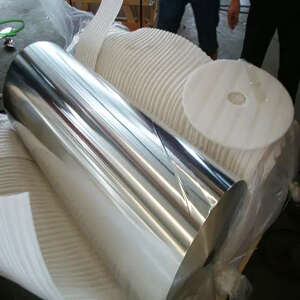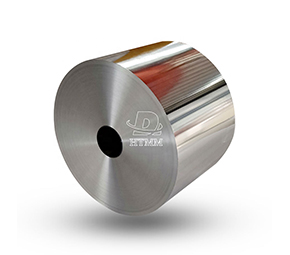 High quality double zero aluminum foil process technology
High quality double zero aluminum foil process technology
HTMM leading double zero aluminium foil manufacturer,factory supply High quality aluminum foil,double zero aluminium foil all specification custom available
Surface Quality
The surface of the rolled billet should be free of cracks, scratches, metal and non-metal indentations, oil spots and other dirt. In order to make the surface clean, eliminate the segregation layer, and ensure the smoothness of the rolled surface, the ingot used for processing aluminum foil must be milled; proper heat treatment of the cast-rolled billet is very beneficial to improve the structure and surface quality; accurately Controlling the hot rolling temperature has an important effect on the fibrous structure and mechanical properties of the aluminum foil blank; keep the rolls and roller tables clean, and remove the adhered debris in time; choose high-quality emulsion and rolling oil as cooling lubricants, and maintain the best physical and chemical indicators, It is an important measure to prevent aluminum sticking and scratching the surface; and the fully automated transportation and stacking device can effectively prevent surface damage.
Thickness tolerance
The rolling mill is equipped with AGC thickness online measurement and adjustment system, which can obtain accurate dimensional tolerances. The chemical composition of the aluminum foil blank must be strictly controlled within the specified range, because its change will have a great impact on the accuracy of the X-ray thickness gauge. The longitudinal thickness tolerance of Alcon's cast-rolled plate: 7.0±1.5%mm, ideal convexity 0.03~0.04mm (0.5~0.6%); the convexity of the hot rolled strip is less than 0.5%, and the longitudinal thickness tolerance is less than ±0.8% ; Japan’s requirements for the longitudinal thickness tolerance of cold-rolled aluminum foil blanks are 0.3mm±5μm, and the transverse thickness tolerance is ±1.7μm (0.56%); the measured value of the thickness tolerance of the 0.3mm thick aluminum foil blanks imported from South Korea is less than 2.7%; provided by SMS The technical conditions of cold rolling mill guarantee thickness tolerance: 0.3mm±2~3%.
Plate quality
Exquisite plate shape detection and adjustment technology can ensure the production of flat aluminum foil blanks. AFC system, HC system (high crown), VC system (variable crown), CVC system (continuously variable crown), HSC system (roll horizontal displacement), UPC system (universal profile control), TP system ( The use of tapered plunger) and DSR system (dynamic crown) makes the shape control level of aluminum foil blanks higher and higher. The flatness deviation of the hot-rolled billet does not exceed 30 I; the flatness of the online plate surface of the SMS cold rolling mill can reach 10-15 I. The cast-rolled billet and the strip rolled by the hot finishing mill should have a slight convexity, rather than a concave degree, because the center of the strip can accommodate more stress than the edges and still maintain its flatness. For pure aluminum materials, in order to prevent fins on the edges and ensure good calenderability during the next cold rolling and aluminum foil rolling, it is often required to have a narrow range of 0.8-1.2% plate crown ratio after hot rolling. For wide aluminum foil blanks, in order to optimize the calenderability of the aluminum foil and the shape of the coil during sub-rolling, the convexity of the blank is required to be 0.5% or less.
Aluminum foil rolling technology
The rolling of aluminum foil generally starts from a 0.3-0.6mm thick cold-rolled billet, and after rough, medium and finish rolling to 5-20μm foil, it requires 5-6 passes, and the processing rate of each pass is 50-60 %, double rolling is required for the last pass.
The characteristics of aluminum foil rolling are gapless rolling and double rolling on a finishing mill. In aluminum foil rolling, when the thickness is rolled to less than 0.05mm, it is in a roll-gap rolling state, and the resulting rolling force and roll elasticity are very large. At this time, if you want to control the thickness of the aluminum foil, it mainly depends on adjusting the rolling speed, tension, roll surface roughness and rolling oil physical and chemical indicators. However, adjusting the pressing device cannot effectively change the thickness of the aluminum foil. This is very different and difficult from cold rolling deformation.



.jpg)


